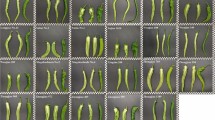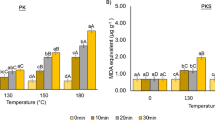Abstract
In this study, we examined the chemical quality (total protein, total lipid, starch, piperine, and essential oil contents) and flavour quality of white pepper (Piper nigrum L.) derived from grafted and non-grafted plants over 3 years. We employed gas chromatography mass spectrometry (GC–MS) to analyse major volatiles and sensory evaluation to assess the flavour quality of white pepper derived from grafting and non-grafting. Within the six groups of white pepper samples, few differences were found in their chemical composition, and most features were primarily considered the same. However, the total lipid content was much higher in the non-grafting samples than in the grafted samples. The reason for this difference was likely due to stock grafting from diverse sources, which affected the transport of some nutrients, but the difference in lipid content was not necessarily large. The characterization of the main chemical compounds (caryophyllene, cyclohexene, caryophyllene oxide, and isospathulenol), volatile compounds, and volatile profiles of two treatments (grafted and non-grafted plants) and three samples were taken from each treatment showed little differences across all of the samples, perhaps indicating that grafting had little effect on the aroma components of white pepper. We examined the volatile compounds of white pepper derived from six groups by principal component analysis (PCA) to support our sensory and instrumental data. These results suggest that grafting is promising for the cultivation of Piper nigrum L.



Similar content being viewed by others
References
Ramakrishnan Nair R, Dutta Gupta S (2003) Somatic embryogenesis and plant regeneration in black pepper (Piper nigrum L.): Direct somatic embryogenesis from tissues of germinating seeds and ontogeny of somatic embryos. J Hortic Sci Biotechnol 78(3):416–421
Ahmad N, Fazal H, Abbasi BH, Rashid M, Mahmood T, Fatima N (2010) Efficient regeneration and antioxidant potential in regenerated tissues of Piper nigrum L. Plant Cell Tissue Organ Cult 102(1):129–134
Abbasi BH, Ahmad N, Fazal H, Mahmood T (2010) Conventional and modern propagation techniques in Piper nigrum. J Med Plant Res 4:007–012
Khan S, Mirza KJ, Anwar F, Abdin MZ (2010) Development of RAPD markers for authentication of Piper nigrum L. Environ We Int J Sci Technol 5:553–562
Jiang Y, Liu J (2011) Analysis of genetic diversity of Piper spp. in Hainan Island (China) using inter-simple sequence repeat ISSR markers. Afr J Biotechnol 10(66):14731–14737
Zheng W (1999) Germplasm resources of wild pepper and their use. Guangxi Sci Technol Trop Crops 73:12–13
Ravindran P (2000) Black Pepper, Piper Nigram: Piper nigrum, vol 13. CRC
Hao CY, Xia ZQ, Fan R, Tan LH, Hu LS, Wu BD, Wu HS (2016) De novo transcriptome sequencing of black pepper (Piper nigrum L.) and an analysis of genes involved in phenylpropanoid metabolism in response to Phytophthora capsici. BMC Genomics 17:822–835
Mammootty KP, Abraham K, Vijayaraghavan R (2008) Screening black pepper (Piper nigrum L.) varieties/cultivars against Phytophthora disease in the nursery. J Trop Agric 46(1–2):70–72
Suseela Bhai R, Anandaraj M, Sarma YR, Veena SS, Saji KV (2007) Screening of black pepper (Piper nigrum L.) germplasm for resistance to foot rot disease caused by Phytophthora capsici Leonian. J Spices Aromatic Crops 16(2):115–117
Colla G, Rouphael Y, Leonardi C, Bie Z (2010) Role of grafting in vegetable crops grown under saline conditions. Sci Hort 127:147–155
Tsaballa AC, Athanasiadis K, Pasentsis I, Ganopoulos I, Nianiou-Obeidat TA (2013) Molecular studies of inheritable grafting induced changes in pepper (Capsicum annuum) fruit shape. Sci Hort 149:2–8
Lee JM, Kubota C, Tsao SJ, Bie Z, Hoyos Echevarria P, Morra L, Oda M (2010) Current status of vegetable grafting: diffusion, grafting techniques, automation. Sci Hort 127:93–105
Condurso C, Cincotta F, Tripodi G, Verzera A (2017) Bioactive volatiles in Sicilian (South Italy) saffron: safranal and its related compounds. J Essent Oil Res 29:221–227
Steinhaus M, Schieberle P (2005) Characterization of odorants causing an atypical aroma in white pepper powder (Piper nigrum L.) based on quantitative measurements and orthonasal breakthrough thresholds. J Agric Food Chem 53:6049–6055
Dominique F, Amaral ACF, Gérzia MC, Leon ALL, Silva JRDA (2012) Chemical and biological analyses of the essential oils and main constituents of Piper species. Molecules 17:1819–1829
Jagella T, Grosch W (1999) Flavour and off-flavour compounds of black and white pepper (Piper nigrum L.) I. Evaluation of potent odorants of black pepper by dilution and concentration techniques. Eur Food Res Technol 209:16–21
Jagella T, Grosch W (1999) Flavour and off-flavour compounds of black and white pepper (Piper nigrum L.) II. Odour activity values of desirable and undesirable odorants of black pepper. Eur Food Res Technol 209:22–26
Guerrini A, Sacchetti G, Rossi D, Paganetto G, Muzzoli M, Andreotti E, Tognolini M, Maldonado ME, Bruni R (2009) Bioactivities of Piper aduncum L. and Piper obliquum Ruiz & Pavon (Piperaceae) essential oils from Eastern Ecuador. Environ Toxicol Pharmacol 27:39–48
Santos PRD, Moreira DL, Guimarães EF, Kaplan MAC (2001) Essential oil analysis of 10 Piperaceae species from the Brazilian Atlantic forest. Phytochemistry 58:547–551
Maia JGS, Andrade EHA (2009) Database of the Amazon aromatic plants and their essential oils. Quim Nova 32:595–622
Hao CY, Fan R, Qin XW, Hu LS, Tan LH, Xu F, Wu BD (2018) Characterization of volatile compounds in ten Piper species cultivated in Hainan Island, South China. Int J Food Prop 21(1):633–644
Mazida MM, Salleh MM, Osman H (2005) Analysis of volatile aroma compounds of fresh chilli (Capsicum annuum) during stages of maturity using solid phase micro extraction (SPME). J Food Compos Anal 18:427–437
Wood A, Barrow ML, James D (1988) Piperine determination in pepper (Piper nigrum L.) and its oleoresins—a reversed-phase high-performance liquid chromatographic method. Flavour Fragr J 3(2):55–64
Orav A, Stulova I, Kaila T, Muuisepp M (2004) Effect of storage on the essential oil composition of Piper nigrum L. fruits of different ripening states. J Agric Food Chem 52:2582–2586
Waje CK, Kim HK, Kim KS, Todoriki S, Kwon JH (2008) Physicochemical and microbiological qualities of steamed and irradiated ground black pepper (Piper nigrum L.). J Agric Food Chem 56(12):4592–4596
Parthasarathy VA, Chempakam B, Zachariah TJ (2008) Chemistry of spices. CABI
Jagella T, Grosch W (1999) Flavour and off-flavour compounds of black and white pepper (Piper nigrum L.) III. Desirable and undesirable odorants of white pepper. Eur Food Res Technol 209(1):27–31
Nitz S (1996) Quality and stability of high-pressure extracts from spices. In: Forschungskreis der Ernährungsindustrie. Bonn, Germany (pp. 85–111) (in German)
Helmig D, Ortega J, Duhl T, Tanner D, Guenther A, Harley P, Wiedinmyer C, Milford J, Sakulyanontvittaya T (2007) Sesquiterpene emissions from pine trees–identifications, emission rates and flux estimates for the contiguous United States. Environ Sci Technol 41(5):1545–1553
Ciccioli P, Brancaleoni E, Frattoni M, Di Palo V, Valentini R, Tirone G, Seufert G, Bertin N, Hansen U, Csiky O, Lenz R, Sharma M (1999) Emission of reactive terpene compounds from orange orchards and their removal by within-canopy processes. J Geophys Res 104:8077–8094
Degenhardt D, Lincoln DJ (2006) Volatile emissions from an odorous plant in response to herbivory and methyl jasmonate exposure. Chem Ecol 32:725–743
De Moraes C, Mescher M, Tumlinson J (2001) Caterpillar-induced nocturnal plant volatiles repel conspecific females. Nature 410(6828):577–580
Schuh G, Heiden A, Hoffmann T, Kahl J, Rockel P, Rudolph J, Wildt J (1997) Emissions of volatile organic compounds from sunflower and beech: dependence on temperature and light intensity. J Atmos Chem 27(3):291–318
Bouajaj S, Benyamna A, Bouamama H, Romane A, Falconieri D, Piras A, Marongiu B (2013) Antibacterial, allelopathic and antioxidant activities of essential oil of Salvia officinalis L. growing wild in the Atlas Mountains of Morocco. Nat Prod Res 27(18):1673–1676
Hillig Karl W (2004) A chemotaxonomic analysis of terpenoid variation in Cannabis. Biochem Syst Ecol 32(10):875–891
Qin XW, Lai JX, Tan LH, Hao CY, Li FP, He SZ, Song YH (2017) Characterization of volatile compounds in Criollo, Forastero, and Trinitario cocoa seeds (Theobroma cacao L.) in China. Int J Food Prop 20:2261–2275
Hadi MAME, Zhang FJ, Wu FF, Zhou CH, Tao J (2013) Advances in fruit aroma volatile research. Molecules 18:8200–8229
Krysiak W, Majda T, Nebesny E (2007) An effect of relative air humidity on the content of volatile compounds in roasting cocoa beans. In: Vivian NP (eds) Focus on Food Engineering Research and Development. Nova Science, Inc. p 467–482
Quijano-Abril MA, Callejas-Posada R, Miranda-Esquivel DR (2006) Areas of endemism and distribution patterns for Neotropical Piper species (Piperaceae). J Biogeogr 33:1266–1278
Varughese T, Unnikrishnan PK, Deepak M, Balachandran I, Shree ABS (2016) Chemical composition of the essential oils from stem, root, fruit and leaf of Piper longum Linn. J Essent Oil Bearing Plants 19:52–58
Mamatha B, Prakash M, Nagarajan S, Bhat K (2008) Evaluation of the flavor quality of pepper (Piper nigrum L.) cultivars by GC-MS, electronic nose and sensory analysis techniques. J Sens Stud 23(4):498–513
Narasimhan S, Rajalakshmi D, Chand N (2007) Quality of powdered black pepper (Piper nigrum L.) during storage II. Principal components analyses of GC and sensory profiles. J Food Qual 15(1):67–83
Lilie M, Hein S, Wilhelm P, Mueller U (2007) Decontamination of spices by combining mechanical and thermal effects-an alternative approach for quality retention. Int J Food Sci Technol 42(2):190–193
Funding
This study was partially supported by National Tropical Plants Germplasm Resource Center and Central Public-interest Scientific Institution Basal Research Fund for Chinese Academy of Tropical Agricultural Sciences (No. 1630142017016).
Author information
Authors and Affiliations
Corresponding author
Ethics declarations
Conflict of interest
The authors declare that they have no conflict of interest.
Compliance with ethics requirements
This article does not contain any studies with human or animal subjects.
Informed consent
Not applicable.
Additional information
Publisher's Note
Springer Nature remains neutral with regard to jurisdictional claims in published maps and institutional affiliations.
Rights and permissions
About this article
Cite this article
Fan, R., Qin, XW., Hu, RS. et al. Studies on the chemical and flavour qualities of white pepper (Piper nigrum L.) derived from grafted and non-grafted plants. Eur Food Res Technol 246, 2601–2610 (2020). https://doi.org/10.1007/s00217-020-03600-1
Received:
Revised:
Accepted:
Published:
Issue Date:
DOI: https://doi.org/10.1007/s00217-020-03600-1




